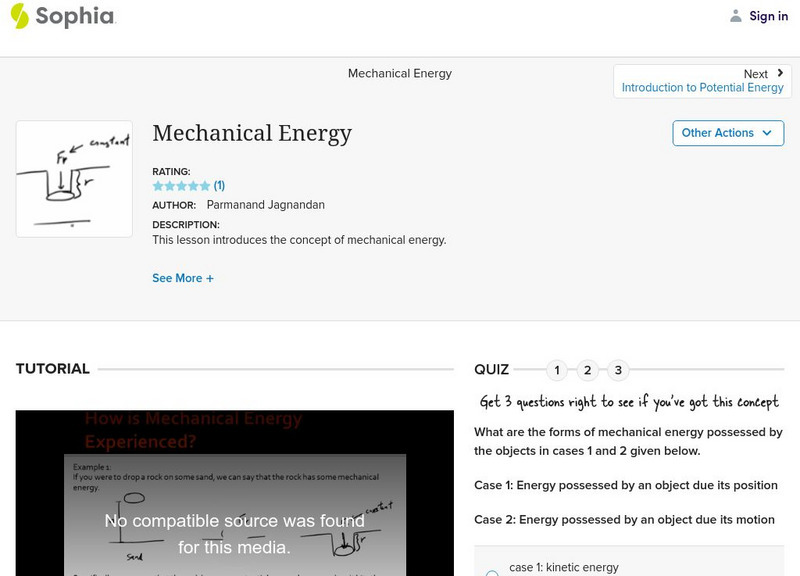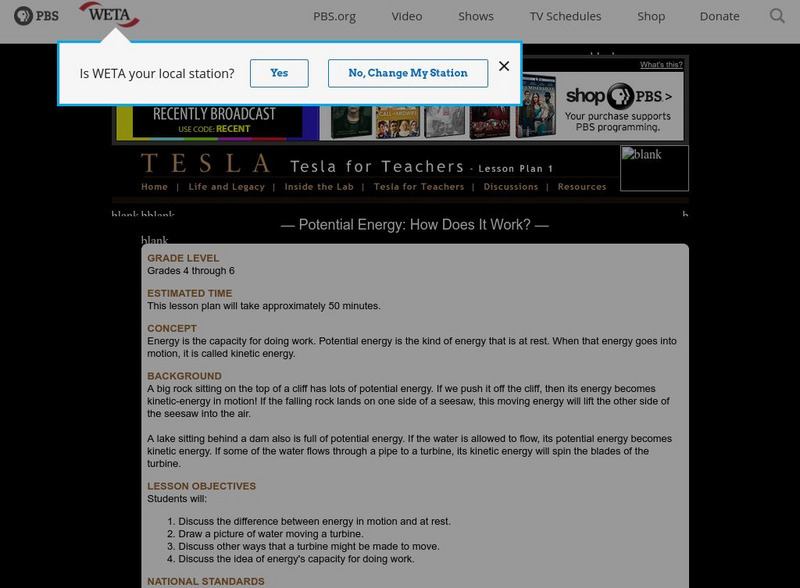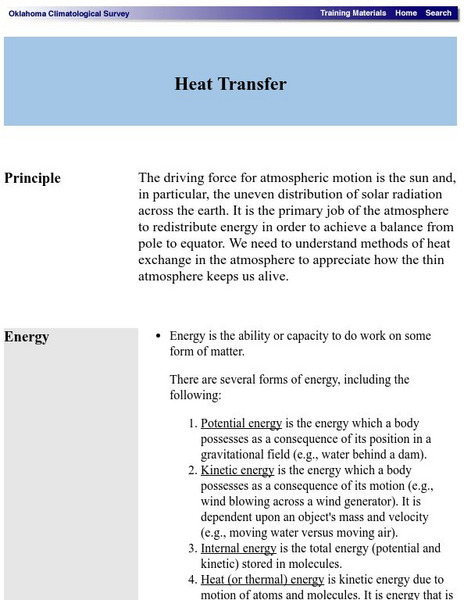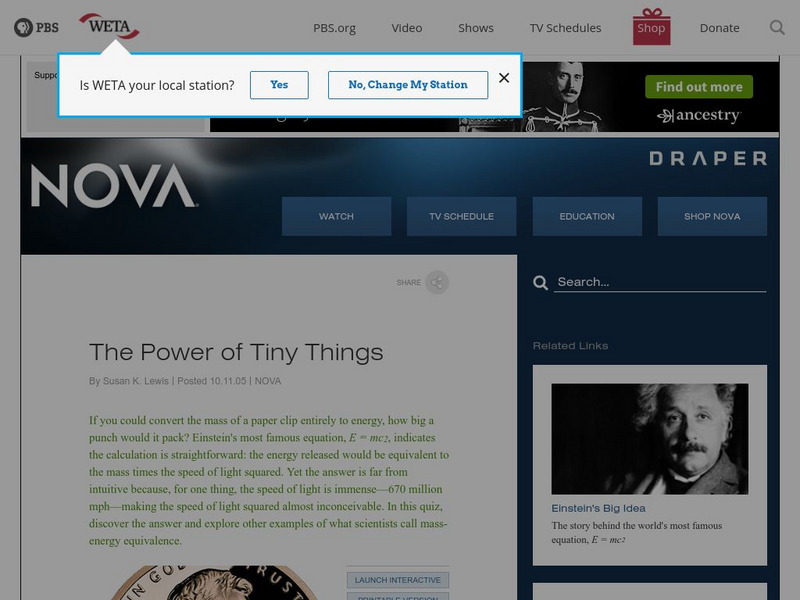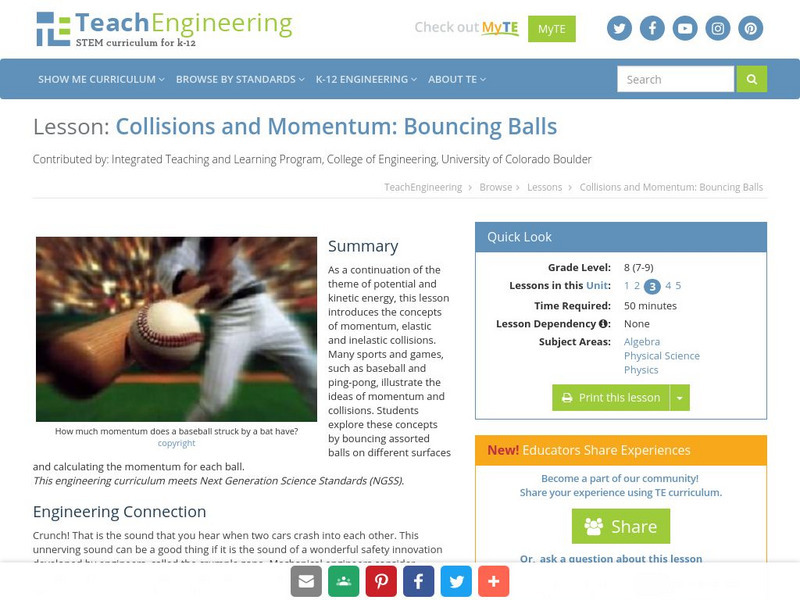Sophia Learning
Sophia: Mechanical Energy
Understand when objects have mechanical energy with this video lesson. Also learn the difference between potential and kinetic energy. The video also discusses the factors that influence both potential and kinetic energy using examples....
PBS
Pbs Teachers: Potential Energy: How Does It Work?
Describe the difference between energy in motion and at rest, and demonstrate energy's capacity for doing work. Draw a picture of water moving a turbine, and discuss other ways that a turbine might be made to move.
University of Colorado
University of Colorado: Ph Et Interactive Simulations: Reaction & Rate Simulation
Students will learn what causes reactions and what affects the rates of reaction through data collected by conducting several simulated experiments.
Physics Classroom
The Physics Classroom: Potential Energy
The concept of potential energy is explained along with the two forms of potential energy: elastic and gravitational. Discusses what gravitational potential energy is, explains the direct relationship between it and mass and height, and...
Georgia State University
Georgia State University: Hyper Physics: Energy of Falling Object
This site is from the Physics Department at Georgia State University. The reliance upon the law of conservation of energy as an approach to problem-solving is presented and encouraged. It is modeled through a problem involving a...
Oklahoma Mesonet
Oklahoma Climatological Survey: Heat Transfer
A discussion from the Oklahoma Climatological Survey of the thermal factors effecting the movement of air masses in the atmosphere. Numerous topics such as methods of heat transfer, latent heat, phase changes (including sublimation and...
Physics Classroom
The Physics Classroom: Energy Relationships for Satellites
The orbits of satellites are described and an energy analysis is performed. Kinetic, potential and total mechanical energy are explained and applied to the motion of satellites.
Annenberg Foundation
Annenberg Learner: Amusement Park Physics: Roller Coaster
This interesting and interactive exhibit demonstrates how Newton's Laws of Motion impact the design and safety of roller coasters.
PBS
Pbs Nova: The Power of Tiny Things
Have you ever wondered what would happen if you converted the mass of a paper clip into an amount of energy? In this informative quiz, discover the answer, and explore other examples of mass-energy equivalence.
Texas Education Agency
Texas Gateway: Types of Energy
This interactive tutorial provides a brief review of the 2 types of energy and an explanation of the law of of conservation of energy.
US Energy Information Administration
U.s. Eia Energy Kids: Energy Basics
Learn about the definition of energy, the forms that it comes in, and the difference between renewable and nonrenewable sources.
Lumen Learning
Lumen: Boundless Chemistry: Types of Energy
This section of a chemistry textbook reviews the different forms of energy: kinetic, potential, and chemical.
City College of New York
City Technology: Wind Up Toy
A series of three video tutorials with accompanying written instructions demonstrating how to make a wind-up toy.
Physics Aviary
Physics Aviary: Practice Problems: Energy From Elastic Graph
Students must find how much energy has been added to a spring by looking at the Force vs. Spring Length graph.
Physics Aviary
Physics Aviary: Practice Problems: Billy on Hill (Level 1)
Students must predict the distance traveled by a person on a sled. The person will start with potential energy due to gravity and it will turn into KE without loss. They will then lose their energy on a level surface at the bottom of a...
Physics Aviary
Physics Aviary: Practice Problems: Billy on Hill (Level 2)
Students must predict the distance traveled by a person on a sled. The person will start with potential energy due to gravity and then lose some energy on a hill. They will then lose the remaining energy on a level surface. You have to...
Physics Aviary
Physics Aviary: Practice Problems: Jumping Joe
Students must predict the distance traveled by a person on a BMX bike. The person will start with potential energy due to gravity and then convert it into KE. They will then hit a ramp and become a projectile. You have to predict how far...
Physics Classroom
The Physics Classroom: Work, Energy, and Power: Potential Energy
This introduction to potential energy contains illustrated examples, example problems, and interactive exercises for application of learning.
Science Struck
Science Struck: Potential Energy Formula
Explains what is meant by potential energy and demonstrates how to use the formulas for gravitational potential energy, elastic potential energy, and electric potential energy. Includes interactive calculators for the first two formula...
Physics Aviary
Physics Aviary: Work to P Eg Lab
This lab is designed to have students discover the relationship between the work that is done and the changes to height that occur to an object. Students can adjust the amount of energy added to the object. They can test five different...
Physics Aviary
Physics Aviary: Work to P Ee Lab
This lab is designed to have students discover the relationship between the work that is done and the stretch of a spring. Students will get the area under a Force/Stretch graph to find the work given to a spring for a given situation....
Physics Classroom
The Physics Classroom: Electric Potential
This tutorial introduces the concept of electric potential. It relates this concept to the potential energy of a positive test charge at various locations within an electric field. Take the interactive quiz to test your understanding.
Physics Classroom
The Physics Classroom: Motion of a Mass on a Spring
This tutorial investigates the motion of a mass on a spring and how a variety of quantities change over the course of time. Such quantities will include forces, position, velocity and energy - both kinetic and potential energy. Take the...
TeachEngineering
Teach Engineering: Collisions and Momentum: Bouncing Balls
As a continuation of the theme of potential and kinetic energy, this lesson introduces the concepts of momentum, elastic and inelastic collisions. Many sports and games, such as baseball and ping-pong, illustrate the ideas of momentum...


